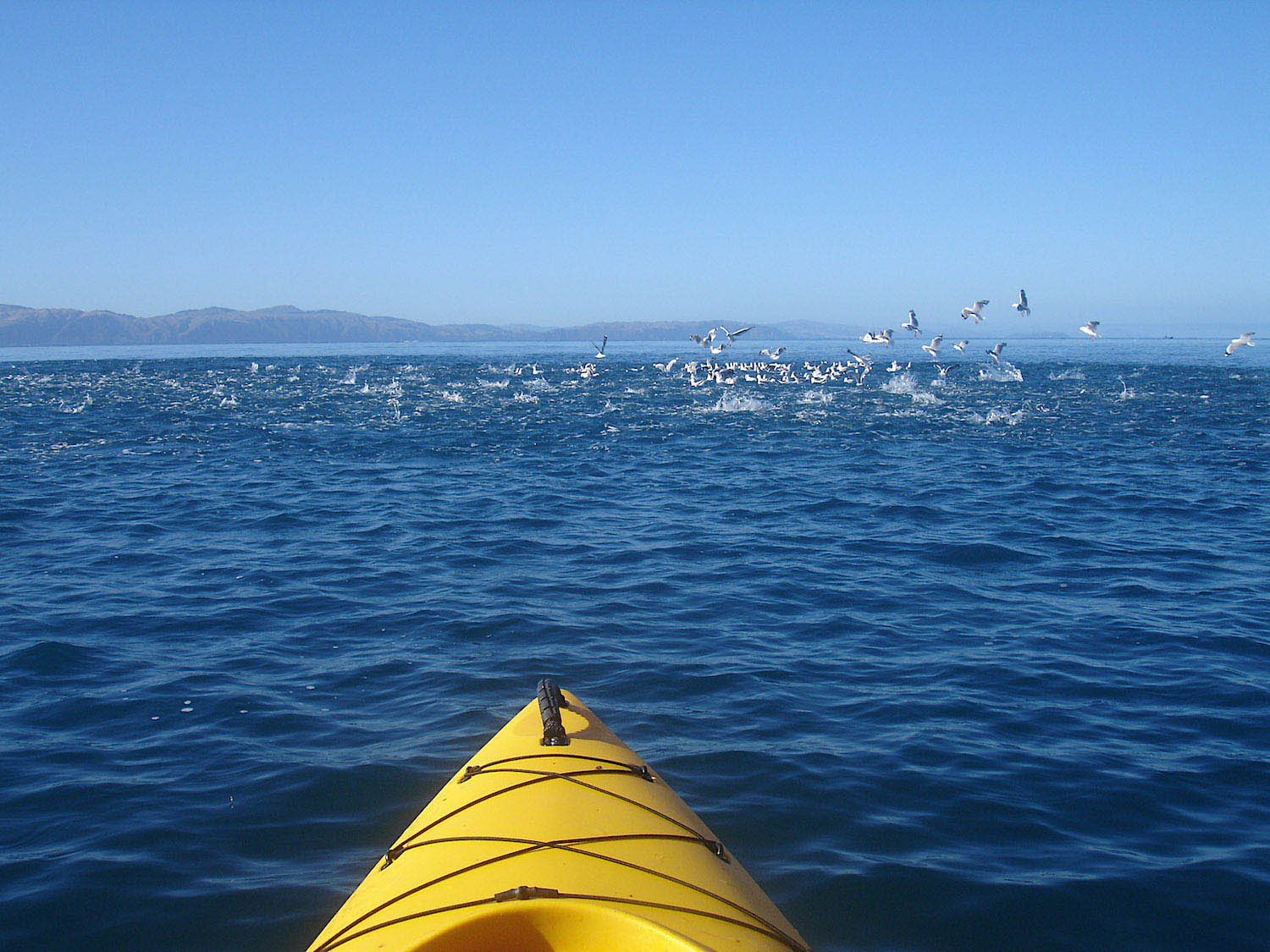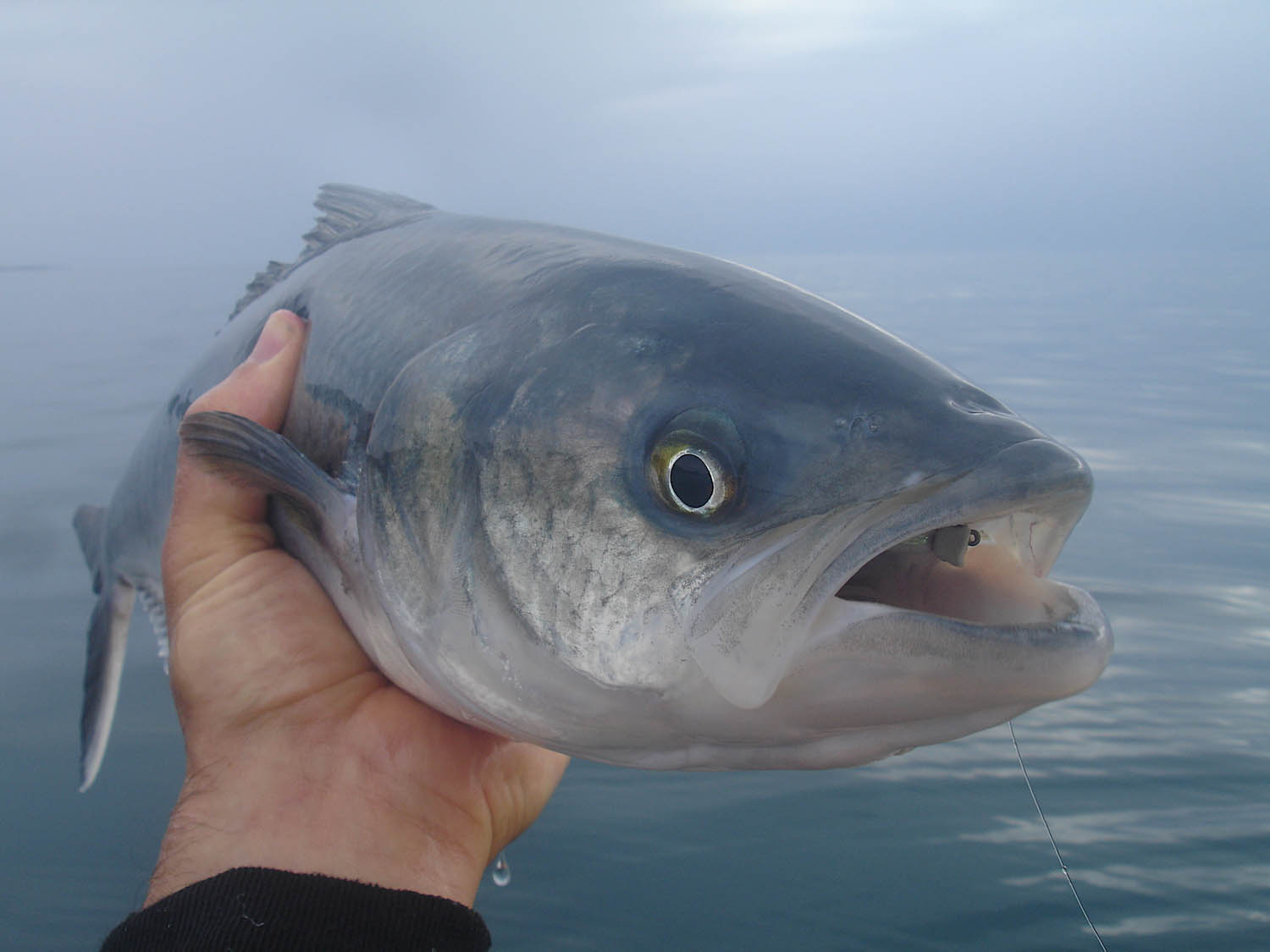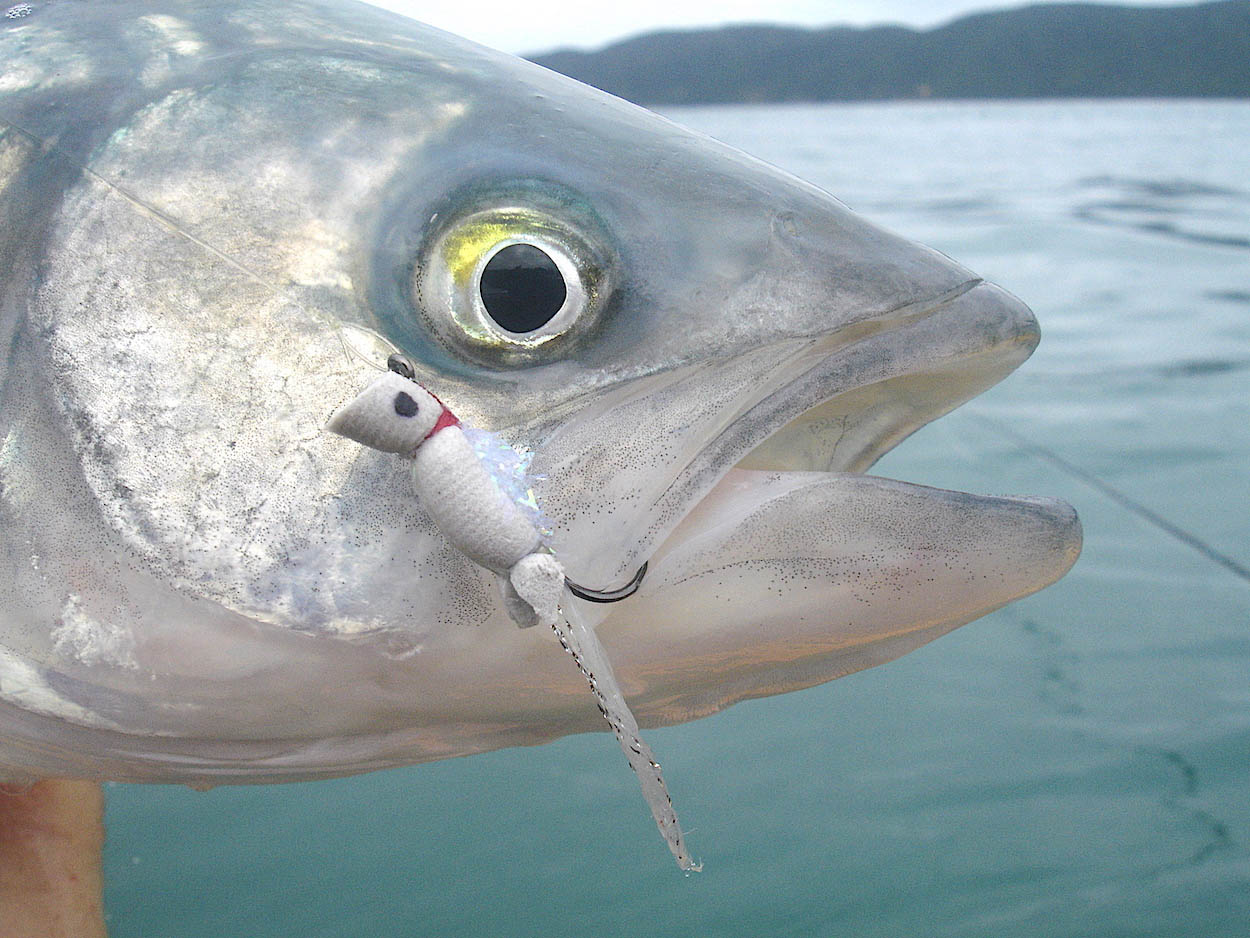
When I was satisfied my Jelly Belly Minnow fly provided the weapon I needed for catching kahawai feeding selectively on baitfish fry; I began experimenting with surface lures to pump up my adrenaline fix from work-ups based on slightly larger prey, like anchovies and young sardines.
I soon discovered that eagle eyed kahawai are no less critical of poppers splashed across the surface than they are when inspecting sub-surface lures. Finding a popper with the right size, form and action to consistently fool them was no trivial task.
I began with a miniature Crease fly, which turned out to be a complete dud: probably because the size 6 version, required to match the local anchovies and young sardines, was a little chunky and not that realistic, often floating on its side. I next tried a size 6 Slim Jim, impressed with this pattern’s slender anchovy-like profile and ease of tying, and while it worked very well some days, especially fished dead drift, it was rejected on others.
I tried various retrieves on difficult days, which usually attracted some interest, but seldom resulted in a fully-fledged strike. And then, whilst attempting to replicate Peter Morse’s Gurgle Pop using alternative materials, I came up with the Gurgle Pop Minnow, with its deadly “pop, dive, wiggle and rise” action. At last I had a fly with the right size, profile and action that works when kahawai like flies dead drift, and when they prefer them with a bit more life-like.
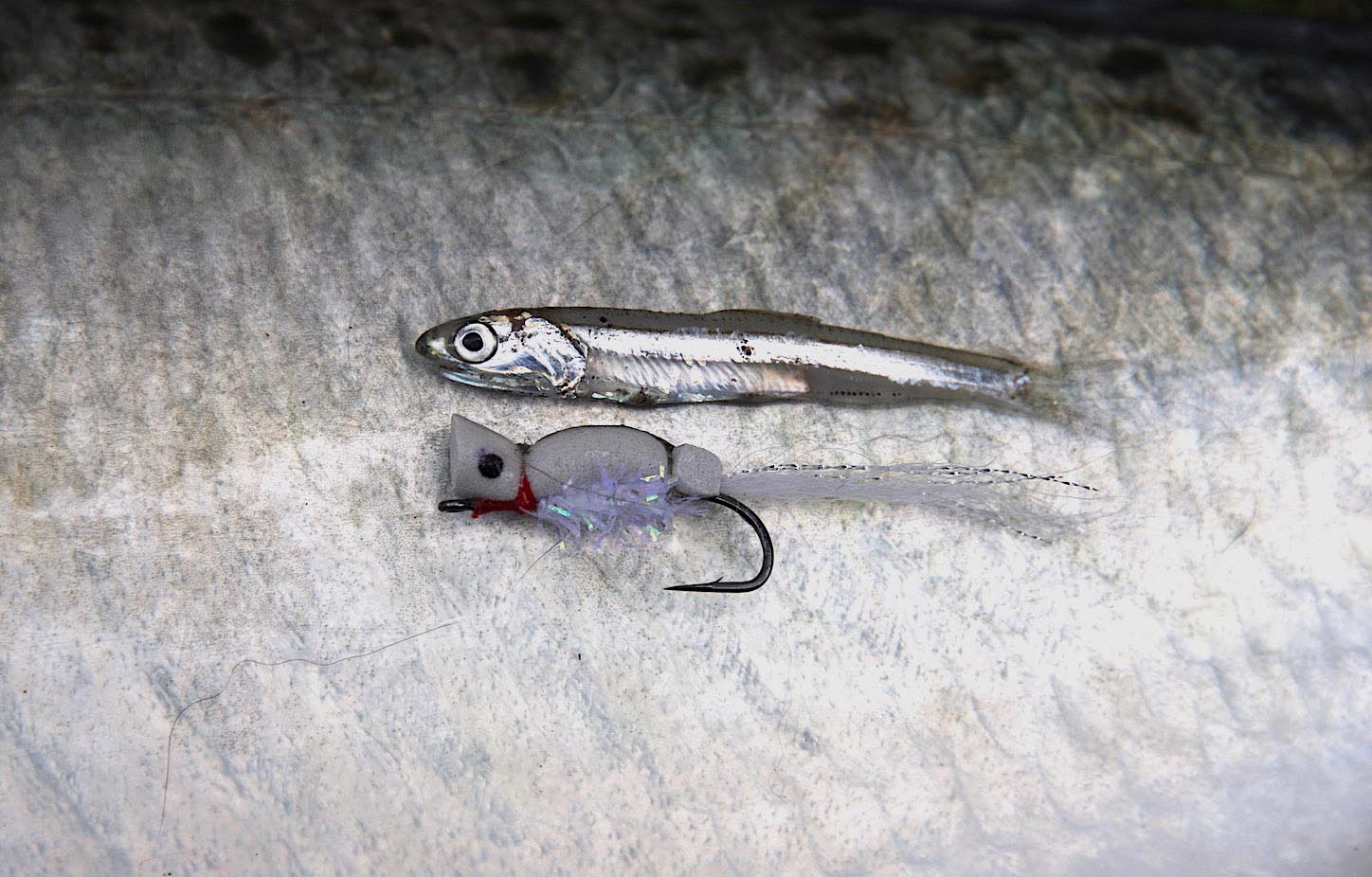
The size 8 GPM is a good match for small anchovies
Peter Morse’s Gurgle Pop was inspired Jack Gartside’s famous Gurgler. Morse ingeniously replaced sheet foam with packing rod foam to create a flat popper face, instead of the traditional Gurgler lip (he also omits the hackle). Unable to obtain packing rod foam with a diameter less than 10mm from my local hardware store, I began experimenting with denser foam cylinders I had cut from EVA foam for tussock cicada bodies and booby eyes. Because the foam did not compress as easily as packing foam, I had to trim the cylinders and then lash them fore and aft onto the hook shank using Garside’s Double Gurgler method, to achieve a skinny baitfish profile.
Trimming the under surface of the rear portion of the cylinder supports the inclusion of an attractive cactus chenille belly (reminiscent of the Estaz Gurgler). Leaving the head portion untrimmed causes the head to lift off the hook when the front portion of the cylinder is lashed to the hook, and when the face is trimmed perpendicular to the shank, a modest, vertically oval popper face is formed - which is key to the pattern’s fortuitous wiggle.
I gave this pattern a new name as it is quite different in construction and action to Morse’s Gurgle Pop, and there is a North American freshwater bass/panfish fly, tied with sheet foam and rubber legs to represent a large insect, that also goes by the name Gurgle Pop. Gurgle Pop Minnow seemed appropriate for my rendition as it imitates small fish and the name aptly captures the pattern’s heritage.
Attributes of the Gurgle Pop Minnow, apart from its deadly action, are that it always lands right way up; it never spins when retrieved rapidly (provided the head is not too long); and it is so durable that flies usually outlast hooks - which often translates to around 50 kahawai (although if you are anal, like me, eyes may need replacing every 10 or 20 fish).
Durability does of course depend on the materials used, and in my experience EVA foam cylinders with a density of around 120 Kg/m3 provide the best trade-off between buoyancy, rigidity and durability. The best tailing material for the Gurgle Pop Minnow is the hair from the tip third of a calf tail. The fibres in this portion of the tail are long, fine, translucent, mobile when wet, and are considerably more durable than bucktail. Craft fur is a suitable substitute, but the fibres tend to matt when fighting fish, requiring a little more maintenance. Bucktail fans hopelessly when under the water, ruining the patterns slim baitfish profile.
Kahawai slashing anchovies at the surface – time for a GPM
Fishing the Gurgle Pop Minnow
The GPM fishes best on a line with intermediate head, and attached to the tippet with a loop knot. Sitting in the water with two thirds of the back and half the head submerged, it is sometimes most effective dead drift, with the occasional twitch. On other occasions the kahawai prefer it moving across the surface with short, sharp 8-12 inch strips; which is when the inherent “pop, dive, wiggle and rise” wounded-baitfish swimming-action makes the JBM so much more effective than anything else I have tried.
Although the GPM does generate bubbles when twitched aggressively, and takes some air along for the dive, it does not explode unrealistically the way conventional larger faced poppers tend to do.
A slower smooth retrieve produces that classic V-wake of a small baitfish swimming just beneath the surface, effectively turning the GPM into a slider. On days when a slow smooth retrieve is the go, a floating line will keep the fly on the surface longer. The disadvantage of floating lines, apart from being harder to cast into the breeze, is that they do not produce the duck-wiggle-rise action achievable with an intermediate, which becomes an issue when fish are looking for more action.
Hits on the GPM range from subtle swirls ... to almighty explosions. Although the reflex is to respond with matching aggression, strip-striking is generally the most effective means of making a solid connection. A strip strike does not rip the lure out of the kahawai’s mouth, and also allows fish that miss their target to have another go. When continuously retrieving the GPM, it is best to keep going until the line tightens.
Originally developed for a bit of surface fun, the GPM has proven to be a highly effective pattern for kahawai feeding on small baitfish at the surface - regularly out-fishing the Clouser Minnow. It has also proved deadly on at least three species of trevally feeding on 3-4inch long juvenile mullet and hardyhead silversides (Atherinidae) in the Cook Island’s Aitutaki lagoon.
This sleek fish, a fiesty kahawai, almost swallowed the Gurgle Pop Minnow
Recipe
Hook: TMC 777SP # 8, or other 2 x long shank hook in size 6
Thread: White/grey and red 140 denier thread
Tail: white calf hair from the tip third of a tail
Flash: Four strands silver Midge or Accent Flash
Shell Back: 1/8 inch Pearl braided ribbon
Body: 6mm foam cylinder, white or pale grey
Belly: Petite Estaz Chenille (Pearl)
Gills: Red thread
Eyes: Black permanent marker over-coated first with super glue and then Sally Hansen’s Hard as nails.
Note: A size 8 TMC777 has the same size gape as a size 6 TMC811S. For a larger popper use a size 6 TMC777 and an 8mm foam cylinder.
Tying Sequence
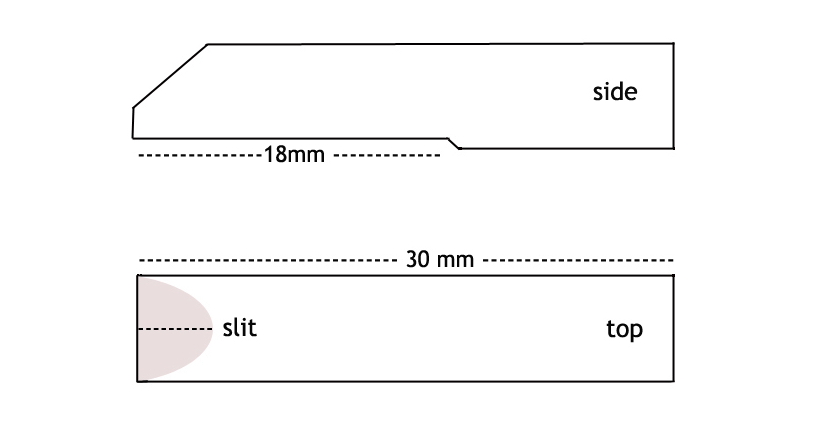
Step 1:
Cut a 3cm length of 6mm diameter foam cylinder and trim as illustrated. The small slit in the rear of the trimmed foam cylinder, illustrated in the dorsal view, allows tail fibres to lift into line with the abdomen.
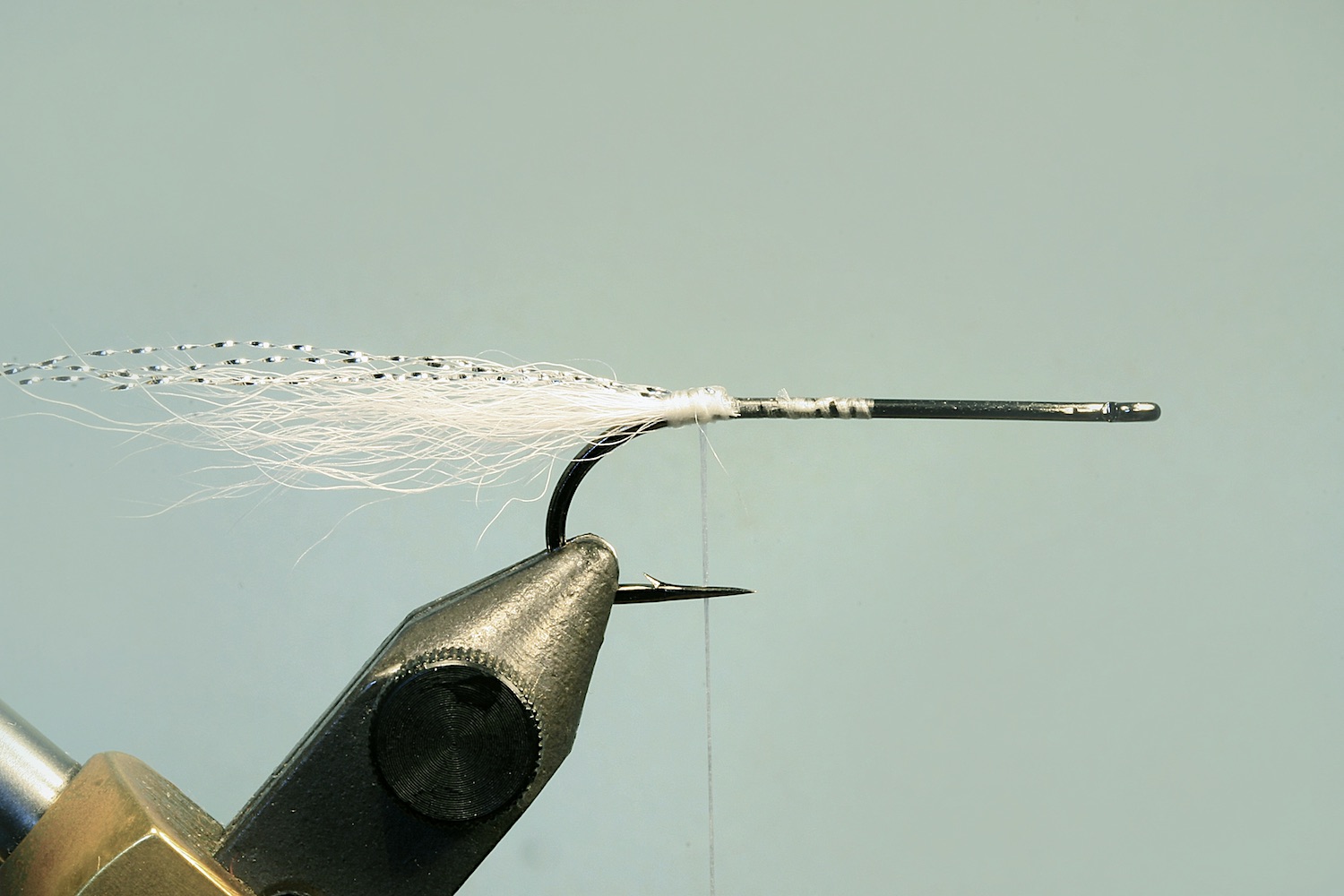
Step 2:
Place a hook in your vice and attach the white thread about half way along the shank. Moving the thread rearward, attach a small tuft of white calf tail just ahead of the bend, and then trim away the butt ends. The tail should be 1-1.5 shank lengths long. Now add four or five strands of silver midge flash.
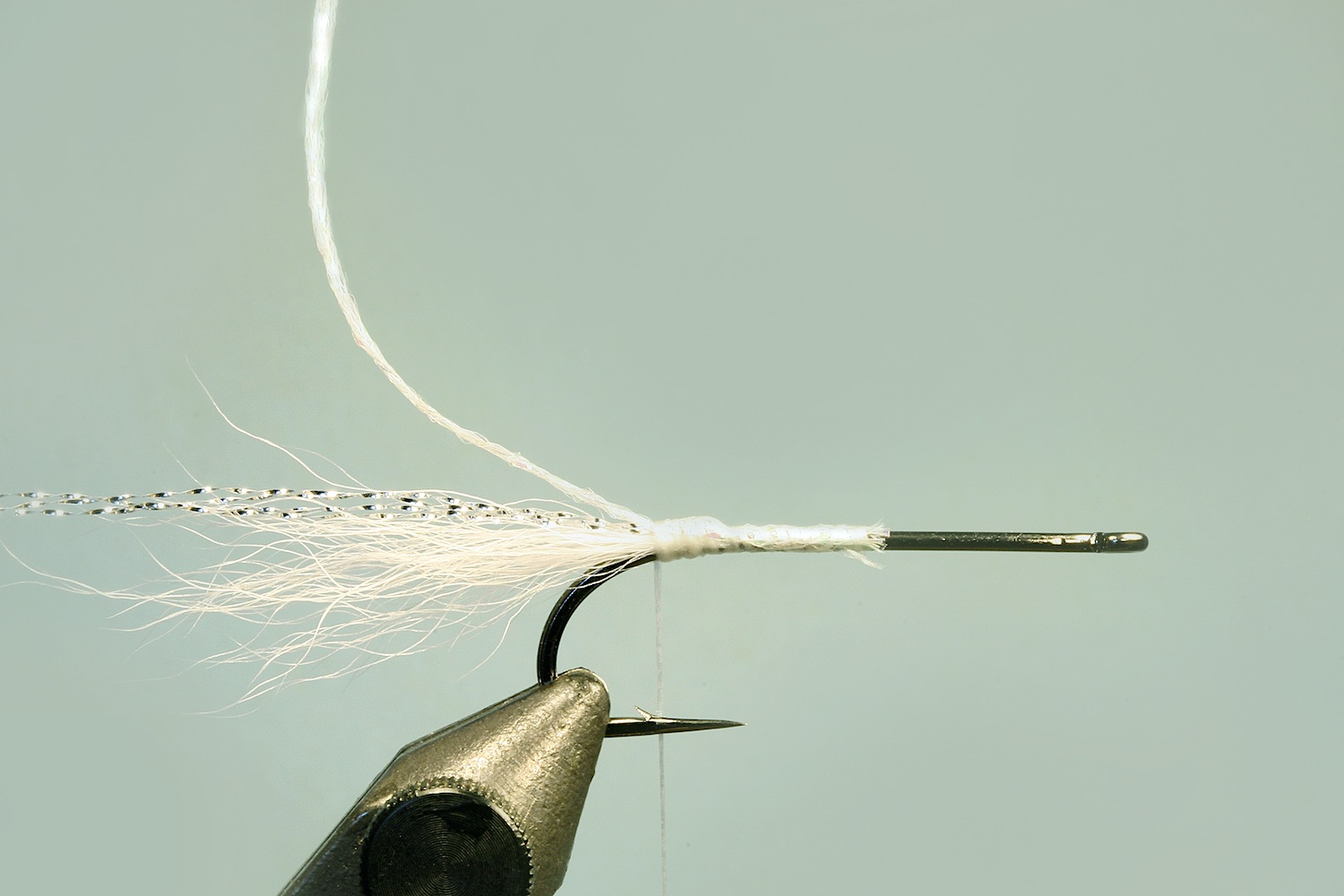
Step 3:
Attach a length of pearl ribbon half way along the shank and then bind it rearward to the end of the thread wraps securing the tail.

Step 4:
Lash the foam cylinder to the rear of the hook with some tight wraps of thread just ahead of the 45 degree taper. The short tapered section should protrude rearward of the tie-in. Place a drop of super glue on the thread wraps securing the foam. Next advance the thread to a point just ahead of the wraps securing the tail and tie in a length of pearl Estaz chenille. Advance the thread a position 5mm behind hook eye.
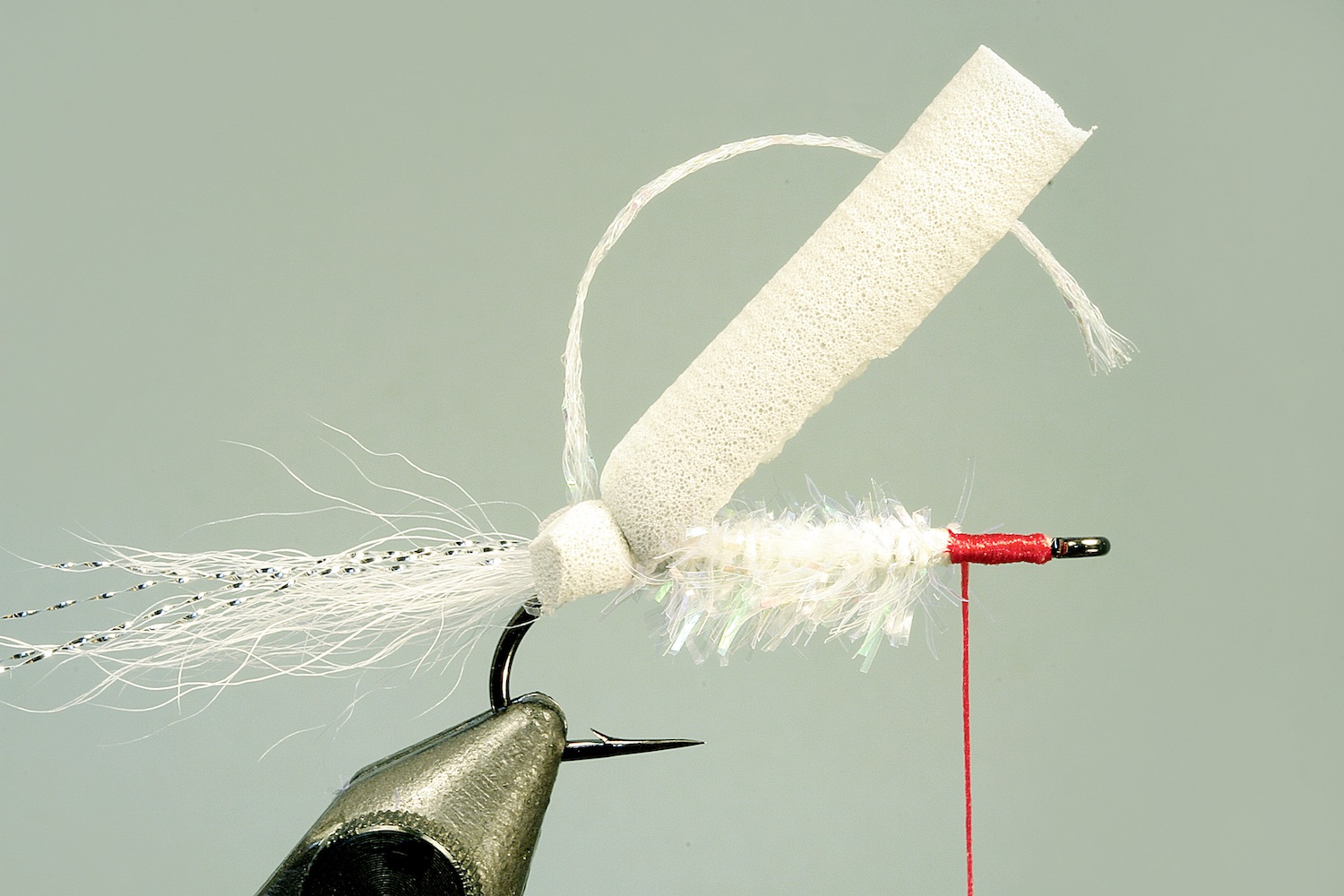
Step 5:
Now twist the Estaz chenille anti-clockwise, to ensure the lurex fibres are evenly distributed around the rope, and wrap forward in closed turns, to a position exactly 5mm behind the hook eye. Tie off the chenille and then advance the thread to the hook eye. Tie off the white thread and attach the red thread, wrapping rearward to a position just in front of the chenille belly. Trim the strands of mylar from the upper surface of the estaz under body.
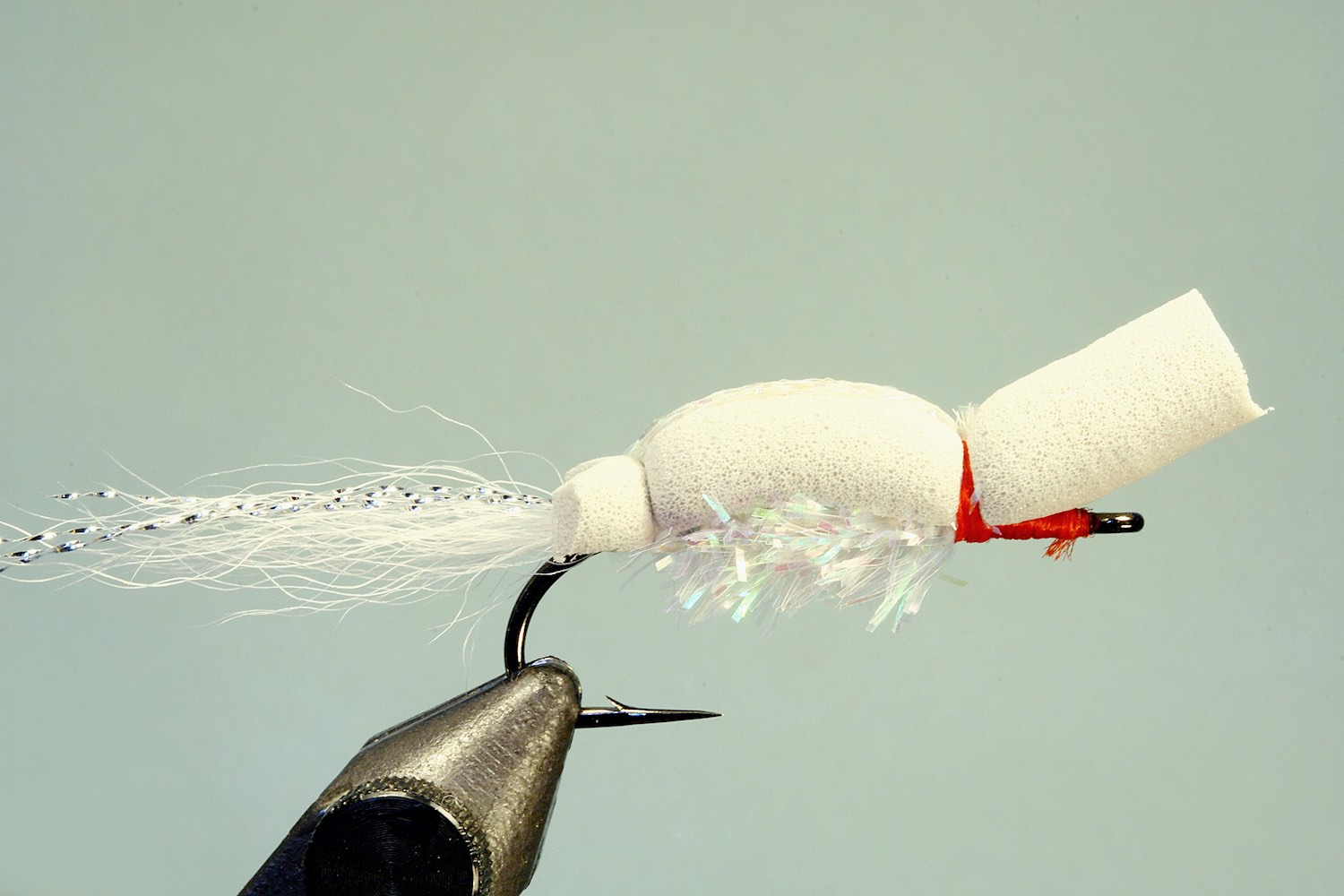
Step 6:
Pull the foam cylinder forward and lash it to the hook with several wraps of thread. Next tie down the shellback and trim away excess. Advance the thread beneath the foam head to the hook eye and tie off with a few half hitches.
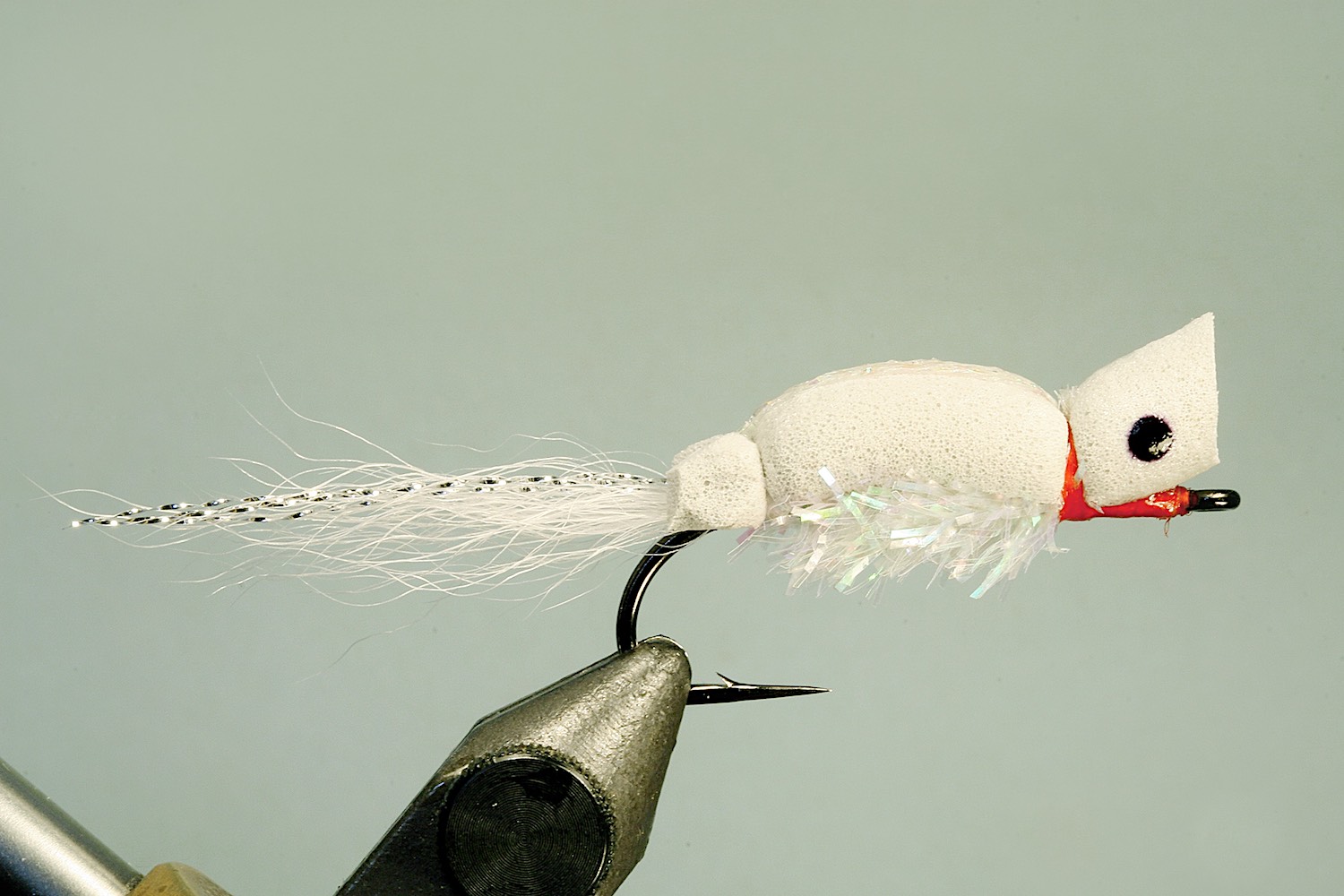
Step 7:
Using a razor blade trim the head vertically at a position half way along the hook eye to produce a flat oval popper face. Next add the eyes using a black permanent marker, and once the ink has dried, coat the eyes, thread wraps and ribbon shell back with super glue. Lift the head with your index finger to ensure that the glue gets between the head and thread wraps to secure the head in place. Once the glue has dried coat eyes and thread wraps with Salley Hansen’s Hard as nails.
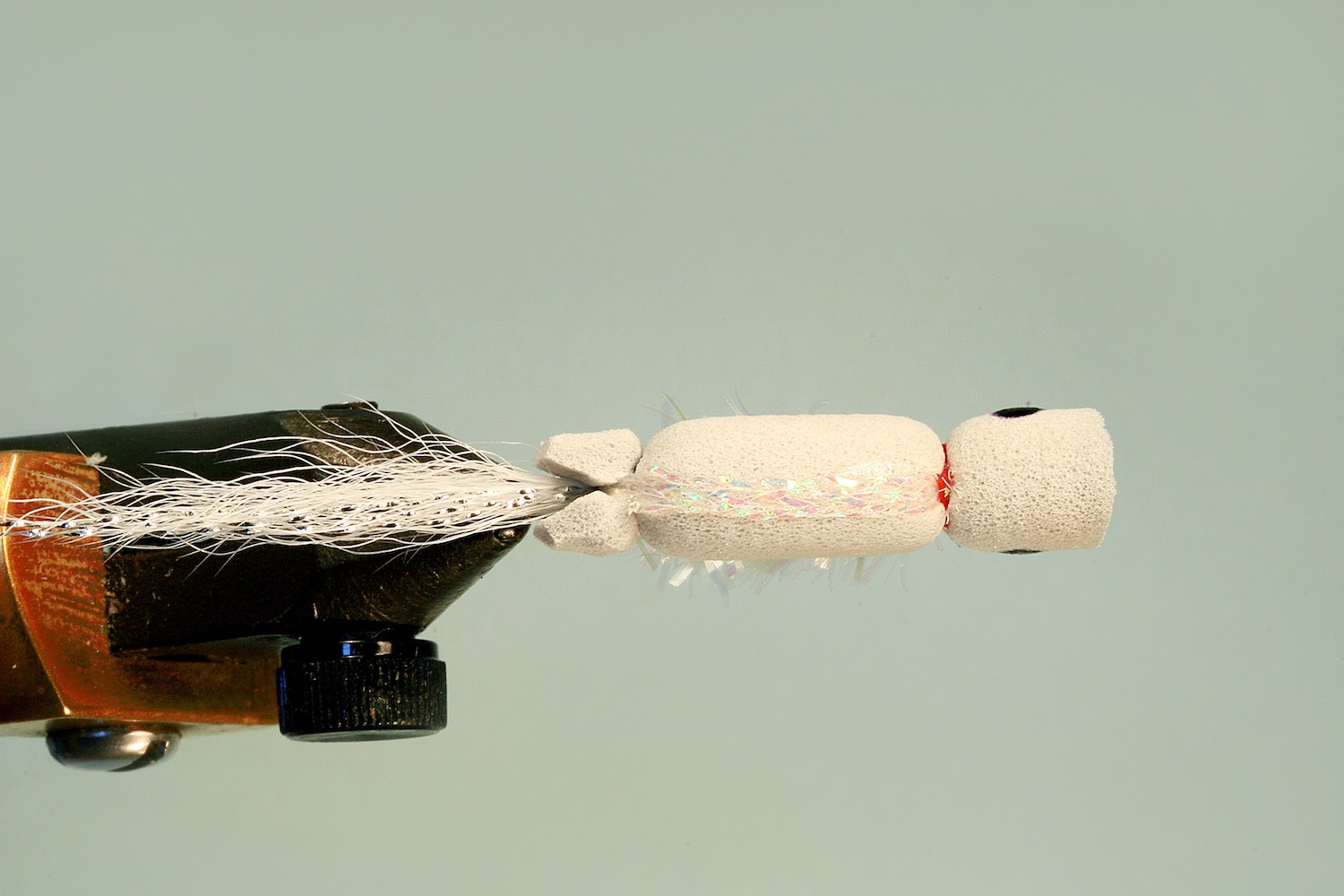
Step 8:
Finally, trim the laterally projecting foam extensions at the rear tie-in with a sharp pair of scissors to create a taper.
+ Effective Spey flies for New Zealand Trout and techniques for fishing them
+ Evolution of the Swing Minnow - A deadly Trout Spey Streamer
+ Introduction to wonders of Stretch Cord
+ Jelly Midge
+ Jelly Bloodworm and Jelly Grub
+ Jelly Caddis
+ Jelly Leg Colly
+ Jelly Bellow Minnow
+ Jelly Crimp Nymph
+ Hot Foam Hopper
+ Hare's Mask Darter
+ Silicone Wing Cicada - Designing the Fly
+ Silicone Wing Cicada - Tying Steps
+ Cutting your own Foam Cylinder

